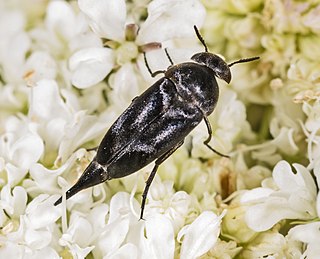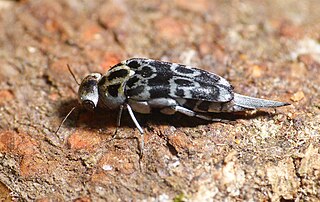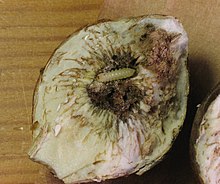
The bean weevils or seed beetles are a subfamily (Bruchinae) of beetles, now placed in the family Chrysomelidae, though they have historically been treated as a separate family. They are granivores, and typically infest various kinds of seeds or beans, living most of their lives inside a single seed. The subfamily includes about 1,650 species and are found worldwide.

The Dytiscidae – based on the Greek dytikos (δυτικός), "able to dive" – are the predaceous diving beetles, a family of water beetles. They occur in virtually any freshwater habitat around the world, but a few species live among leaf litter. The adults of most are between 1 and 2.5 cm (0.4–1.0 in) long, though much variation is seen between species. The European Dytiscus latissimus and Brazilian Megadytes ducalis are the largest, reaching up to 4.5 cm (1.8 in) and 4.75 cm (1.9 in) respectively. In contrast, the smallest is likely the Australian Limbodessus atypicali of subterranean waters, which only is about 0.9 mm (0.035 in) long. Most are dark brown, blackish, or dark olive in color with golden highlights in some subfamilies. The larvae are commonly known as water tigers due to their voracious appetite. They have short, but sharp mandibles and immediately upon biting, they deliver digestive enzymes into prey to suck their liquefied remains. The family includes more than 4,000 described species in numerous genera.

The flea beetle is a small, jumping beetle of the leaf beetle family (Chrysomelidae), that makes up the tribe Alticini which is part of the subfamily Galerucinae. Historically the flea beetles were classified as their own subfamily.

Cerambycinae is a subfamily of the longhorn beetle family (Cerambycidae). The subfamily has a world-wide distribution including: Asia, Europe and the Americas. Within the family, the only subfamily of comparable diversity is the Lamiinae.

Mordella is the type genus of the tumbling flower beetle family (Mordellidae), its subfamily Mordellinae and the tribe Mordellini. It is widely distributed in the Holarctic and adjacent regions. The larvae are primarily dead wood borers.

Glipa is a genus of beetles in the family Mordellidae, containing the following species:

Hoshihananomia is a genus of tumbling flower beetles in the family Mordellidae. There are at least 40 described species in Hoshihananomia.
Mordellaria is a genus of tumbling flower beetles in the family Mordellidae. There are more than 10 described species in Mordellaria.

Falsomordellistena is a genus of tumbling flower beetles in the family Mordellidae, containing the following species:
Glipostenoda is a genus of beetles in the family Mordellidae, containing the following species:
Mordellina is a genus of tumbling flower beetles in the family Mordellidae.

Mordellistena is a genus of beetles in the family Mordellidae, containing the following species:
Neomordellistena is a genus of beetles in the family Mordellidae, containing the following species:
Stenalia is a genus of beetles in the family Mordellidae. It contains the following species:

Mordellinae is a subfamily of beetles commonly known as tumbling flower beetles for the typical irregular movements they make when escaping predators, or as pintail beetles due to their abdominal tip which aids them in performing these tumbling movements.
The Stenaliini are a tribe of beetles in the family Mordellidae.
The Conaliini are a tribe of beetles in the family Mordellidae.
Neomordellistena is a subgenus of the beetle genus Neomordellistena in the family Mordellidae, containing the following species:

The Aleocharinae are one of the largest subfamilies of rove beetles, containing over 12,000 species. Previously subject to large-scale debate whether the subfamily deserved the familial status, it is now considered one of the largest subfamilies of rove beetles.

Saperdini is a tribe of longhorn beetles of the subfamily Lamiinae.















